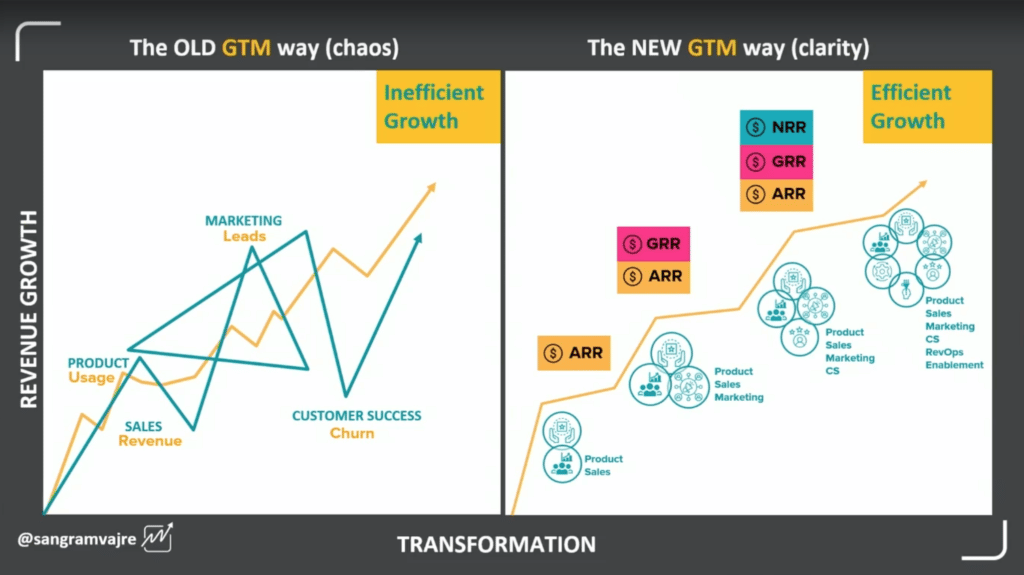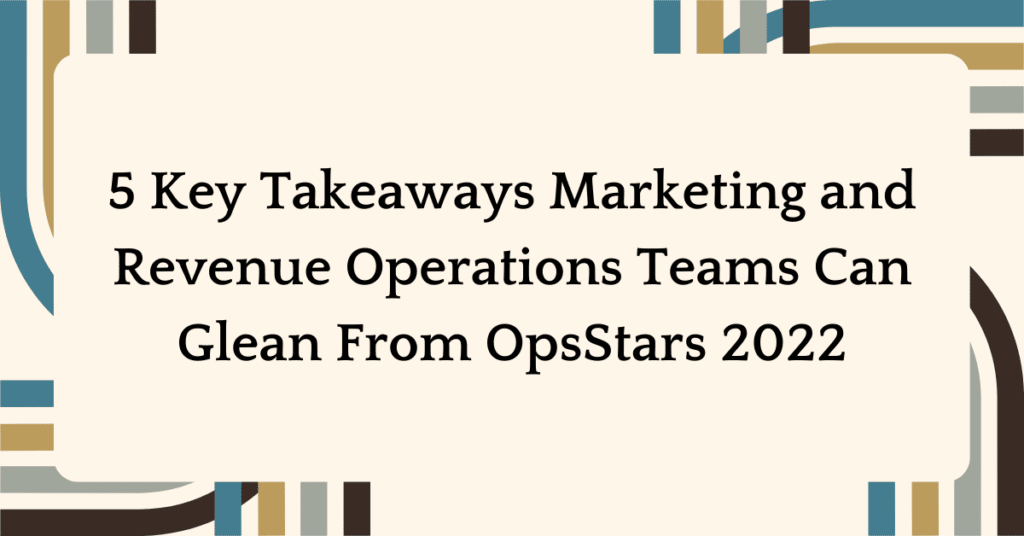Two weeks ago, OpsStars 2022 gathered some of the industry’s most prolific voices to talk all things Marketing and Revenue Operations. From tried and tested best practices to innovative new ideas, attendees left with an arsenal of new strategies to help develop their skills and do more with their teams.
We’ve rounded up the five biggest lessons we learned at this year’s conference that can help kickstart your team’s efforts in Q4 and beyond.
You don’t have a marketing problem. You don’t have a sales problem. You don’t have a customer success problem. You have a go-to-market problem.
Sangram Vajre shared his overview of the next generation’s go-to-market strategy, which for some organizations, has still not evolved to fit the needs of teams today. Although many GTM strategies are rightfully focused on utilizing all revenue-related teams, including Marketing, Sales, and Customer Success, the old GTM model is chaotic and doesn’t focus on the right metrics.
The new way of GTM emphasizes finding ways to grow efficiently while uniting your revenue teams under one leader. 77% of individuals surveyed about their go-to-market strategy reported that a single department owns the GTM strategy in their organization, which can make it difficult for all teams to work together on maximizing its success. Ultimately, the CEO is the owner of an organization’s GTM, which helps the revenue teams feel equally invested in its success. Meanwhile, the Marketing team should act as GTM’s facilitator, helping ensure that each team contributes to the overarching goals rather than focusing only on their department’s KPIs.
GTM isn’t just about who contributes and which numbers you focus on. While in the past, pipeline and revenue were the sole priority, there are new metrics that are critical to the business that your Marketing and Sales teams must also support. Annual recurring revenue, gross retention rate, and net retention rate are all important pieces of the puzzle that today’s GTM strategy must consider. As you build your product and spend time bringing it to market, you can gradually incorporate more teams to make the strategy work. While during the first year, the primary metric will be ARR as a joint effort between Product and Sales, the next couple of years will also look at GRR with additional help from the Marketing team. Eventually, NRR will become a primary focus, including the CS, RevOps, and Enablement teams as key stakeholders.

You can find the full session here.
Today’s market requires every organization to have an account-based marketing strategy that maintains the same care for buyer experience that traditional demand generation does.
Just a few years ago, ABM was viewed as a nice-to-have modern approach to marketing that allowed organizations to drive growth more efficiently. Today, in the wake of a global pandemic and uncertain economic future plagued by labor shortages and inflation, ABM is no longer optional. For teams that are stretched thin, as many are right now, it is a survival tactic.
Jon Miller, founder of Marketo and Engagio and CMO at Demandbase, has found the right way to do ABM that doesn’t necessarily agree with traditional ABM strategies, especially in today’s market. Miller points out that ABM can neglect concern for buyer experience and make for an unpleasant sales journey for the prospect compared to demand generation, which prioritizes buyer experience because of how impactful it is on a lead’s likelihood of converting. Instead, organizations should focus on creating as good of a buyer experience for ABM targets as any traditional target group would have, calling this new version “ABX.”
The key to having a great ABX strategy, even in an economic climate like today’s, where most Marketing teams are being required to achieve more success with fewer resources, is account intelligence. By having access to better intelligence about the accounts you’re targeting, you allow your team to work smarter instead of harder. It takes first-party data, including the wealth of information in your CRM, marketing automation, emails, and meeting notes, and augments it with third-party data, such as information about specific companies and their hierarchies and key contact information. The result is a much more targeted approach that increases effectiveness and efficiency while giving your team the tools and bandwidth it needs to create a better buying experience, a win-win for your organization and your potential clients.
Watch the full session here.
Finding ways to show existing clients the value and ROI of your product is imperative. Data-driven content helps you tell that story.
Nikola Mijic talked listeners through the importance of finding effective ways to nurture the customers you already have and communicate the impact your product or service has had on their work. Especially in today’s economic climate, it is critical that your Sales team does everything it can to support existing clients and focus on renewal and upsell opportunities since these tend to be five times less expensive for your organization to land than acquiring a new customer.
Data-driven stories are particularly compelling, and having a way to capture that data and present it to your client helps your organization prove its ROI. He offers the following best practices to consider as you build out this capability:
- Keep your customer/prospect in mind. Ultimately, this initiative is meant to help them and provide them with clear insights that they can use to decide how they want to proceed with your product. Understanding what they want to get out of this touchpoint, and remembering the goals and objectives they originally had when you first introduced your product to them, helps you tie the data to what they need and tell a more effective story.
- Narratives should build upon one another. Think back to the conversations you had during the pre-sale stage. Any business cases or value propositions you presented were a crucial part of their buyer’s journey and played a key role in helping them to decide to become a customer, so reiterating these points during their customer journey is equally impactful. In all future touchpoints, it’s important to continually tie back to these original goals and conversations to continue building their story and make the value your product brings to the table easier for them to recognize.
- Get feedback both externally and internally. The person or team who is helping Sales pull together the data and analytics to support data-driven content is likely not on the frontlines with customers day to day. Accordingly, the teams who do interact with clients regularly must also be part of building the stories that the data is helping to augment. Customer success, BDRs, SDRs, and other client-facing members of your revenue team can provide insights into which data would be most effective to share and what concerns or interests the story should speak to. Asking “friendly” customers or prospects their thoughts on how you make your data-driven content is also extremely valuable, as it gives you yet another perspective on how to build compelling narratives.
The full session can be found here.
When it’s time for you to secure a budget for your RevOps team, simple is better when presenting your needs and requests to leadership.
A panel of Ops professionals came together to discuss fighting for the resources your team needs to do its job, especially when most organizations are cutting back on everything. But before it’s time to have the budget conversation with your leadership team, it is important to define within your team your definition of ROI clearly, and come to a consensus on what your priorities are for the year and what you need to achieve your goals.
By preparing internally and having a set understanding of what you’re asking for in terms of resources and budget, you can make the actual discussion with external teams clear and concise. When it comes time to present and make your case, sometimes less is more. The ultimate objective is to speak to the organization’s goals, so coming prepared with the problems your team and organization are facing and the exact solutions you have for them is key. Knowing how certain metrics will be impacted by headcount or budget communicates to leaders why it’s important to provide your team with the necessary resources. It puts them in a position to work with you instead of against you to set you up for success.
The full session can be found here.
Customer-led growth equals higher long-term customer value.
How much hidden customer debt does your organization have?
Erol Toker walks listeners through building stronger LTV by using growth strategies that center around the customer and help your teams avoid landing accounts that look like assets but end up putting your future growth on the line. The problems of one team can quickly spread to other areas of the organization and wreak havoc on the entire revenue process.
If, at first glance, your leadership team sees that Sales is not on track to hit its quota, it may request that more top-of-funnel leads are added to help remediate this issue. But when Marketing broadens its messaging to cast a wider net and attract more leads, it leads to an increase in unqualified leads that then causes a capacity problem for your Sales team and, down the line, as these “bad fit” leads become customers, creates a heavy backlog for your engineering team to deal with specific issues facing each client.
It’s clear then that siloed metrics and a disjointed approach to building revenue results in “fake money,” costing your organization more in the long run even though, on paper, your ARR is growing. Instead, it’s important to find ways to focus on customer-led growth and prioritize finding the right customer fit, even if it takes more time to secure revenue from these “good fit” leads. Growing profitably is better than growing quickly. By working across departments to develop a better understanding of your ICP and how to sell to it, your organization will more reliably hit its goals and maintain long-term profitability and growth.
Watch the full session here.

